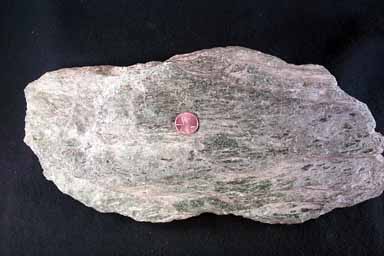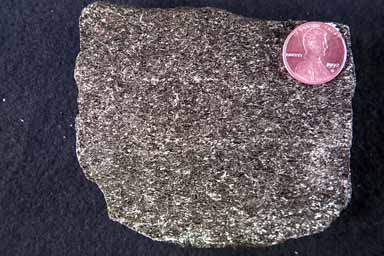
Facies, Zones, and Index Minerals
Measuring the Intensity of Metamorphism
Measuring the Intensity of Metamorphism
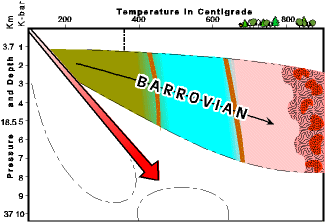
Barrovian metamorphism is the most commonly encountered. It occurs in intense tectonic conditions associated with volcanic arcs, and major mountain building. Barrovian metamorphism is widely found across time and space on all parts of the earth, and produces the most common metamorphic rocks. It is also the most complex, and the most useful metamorphism geologically. Barrovian metamorphism is therefore of particular importance.
Beginning very simply, let's examine what happens to a shale parent rock undergoing a full sequence of Barrovian metamorphism. The metamorphic sequences produces the following rocks, in order: slate, phyllite, schist, and gneiss (click each name or picture to see larger image).
It can be hard to imagine at first that all these very different looking rocks can come from the same sedimentary parent, but we know that they do. This demonstrates the hidden truths that lie within the earth, and to the profound changes that earth processes can effect.
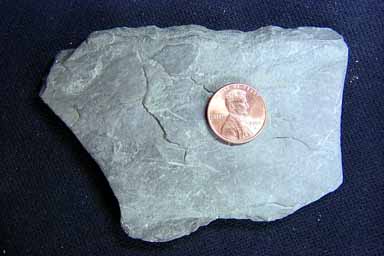 |
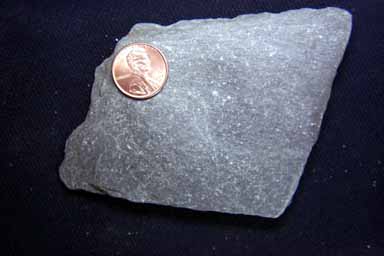 |
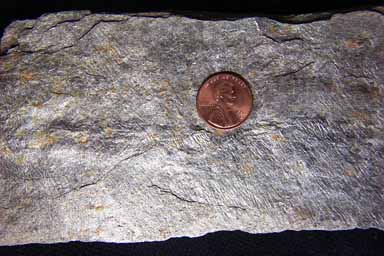 |
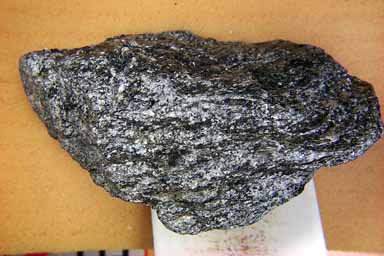 |
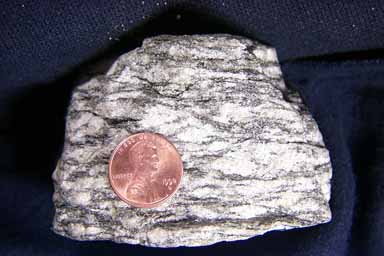 |
MEASURING MEATAMORPHIC INTENSITY
Metamorphism is not rocks, it is a process - a process of burial, heat, and pressure. And so we might ask, " What would happen if these Barrovian processes were to be applied to rocks other than the shale above - all kinds of rocks? Any kind of rock?"
In some ways they will all respond the same, altering their mineralogy and texture to adapt to the new conditions. But how they respond depends very much on exactly what we begin with.
Every parent rock is going to respond to Barrovian metamorphic processes in its own unique way. So, if we were to take a shale, a basalt, a granite - side by side - and metamorphose them all together, each of them responding in its own unique way would produce markedly different looking rocks. Yet, they were all subject to exactly the same metamorphic processes.
This leads us to a problem, and a concept. The problem is, if different parent rocks produce markedly different metamorphic rocks under the exact same conditions, how can we compare them? How can we know when a particular metamorphic rock has experienced the same metamorphic conditions as another rock, especially if they did not firm side by side, but separated on different continents and by billions of years?
The concepts that helps us deal with the problem are metamorphic facies and metamorphic grade. A metamorphic facies is a set or range of temperature and pressure conditions under which metamorphism occurs. A facies is the same regardless of when, or where it takes place, or what the parent rock, or the metamorphic outcome is.
METAMORPHIC FACIES
In Barrovian metamorphism there are three facies. Commonly we call then low, middle, and high grade metamorphism, but geologically they are the greenschist facies, amphibolite facies, and granulite facies. Everything in Barrovian metamorphism is in reference to these three facies, or conditions of metamorphism.
These three facies are, of course, named after the three kinds of rocks, greenschist, amphibolite, and granulite. If we observe a terrane of increasing metamorphic intensity, beginning with a mafic parent, like basalt or gabbro, the parent undergoes a systematic sequence of mineralogic and textural changes, as shown below.
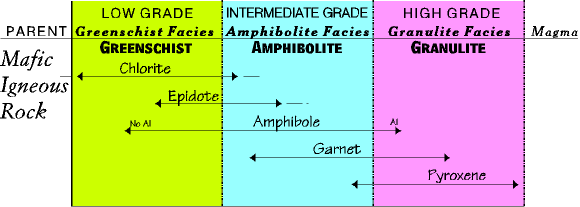
pdf version This sequence of transformations is very diagnostic, and allows us to recognize the same facies of metamorphism any time or place we see one of these rocks. You will observe, however, that these are very different looking rocks produced from the basalt parent, as different as the sequence of metamorphic rocks produced from the shale parent.
Notice that the greenschist is dominated by the mineral chlorite, while the amphibolite by amphibole, and the granulite by pyroxene. Furthermore, all these minerals result from transformations of the same chemistry present in the original basalt.
What happens, however, if we start with a different parent? Because the initial composition is different the metamorphic changes (mineralogy and texture) will be different. With a different parent than mafic we thus need a different scale to measure the same greenschist, amphibolite, and granulite facies. To understand this let's go back and examine the shale parent, and the sequence shale, slate, phyllite, schist, gneiss, magma.
ZONES AND INDEX MINERALS
The second common scale of metamorphic intensity (i.e. facies) begins with a shale, or clay-rich, parent, and uses index minerals and zones to measure metamorphic intensity. This sequence is summarized in the chart below.
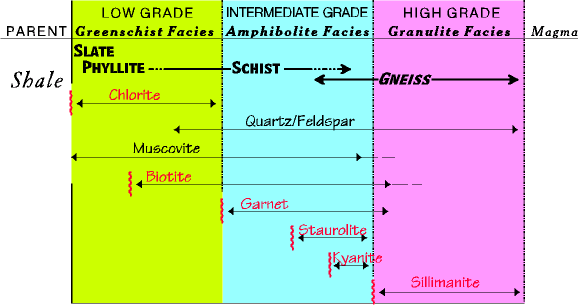
pdf version
Table summarizing shale transformations - pdf
Observe across the top of the chart the ranges of the rocks slate, phyllite, schist, and gneiss. But note that with a few exceptions (e.g. chlorite, garnet) the minerals composing these rocks are not the same as for a mafic parent. The chemistry of the parent rocks are different, so the metamorphic minerals that can be produced are different.
Chlorite is the one common mineral for the greenschist facies (low grade), but after that the mineralogies are different. Quartz, feldspar, and muscovite are relatively universal minerals, and so can not tell us much about the intensity of metamorphism.
Other minerals produced during the metamorphism are special however, because they each form at a specific set of temperature/pressure conditions, which we know, and are thus index minerals (red in the above chart). They are index minerals because they index when, during the metamorphic processes, a particular set of temperature and pressure conditions have been achieved, and they appear in a set order: chlorite, biotite, garnet, staurolite, kyanite, and sillimanite. And because they each form at a higher temperature and pressure, when we first find one of the index minerals in the rock we know a particualr temperature/pressure condition has been achieved.
Imagine walking across a country side where metamorphic rocks are exposed. As you walk you begin in a shale, but bit by bit the texture of the rocks changes into slate, phyllite, schist, and finally gneiss. At the same time the mineralogy is changing, so as we walk we notice the first presence of the index mineral chlorite. The chlorite tells us that metamorphism has begun at this point.
So, we keep walking, and soon the index mineral biotite appears; now we know the metamorphic grade has reached the biotite grade. If we were drawing a map as we went we would mark on the map this first appearance of biotite. In fact, we would wander around finding the first appearance of biotite everywhere, and plotting the points on the map. A line connecting all these first appearances of biotite is an isograd (equal grade), and tells us where in this country side, this big body of metamorphic rock, the temperature and pressure finally reached biotite grade.
We continue this process for each index mineral - garnet, staurolite, kyanite, sillimanite - plotting out the isograd concentric circles that close in tighter and tighter onto the source of the heat causing the metamorphism.
Note on the chart that the ranges of the index minreals overlap, so it is possible to have more than one of these in a rock at the same time. But it is always the higher temperature/pressure index mineral we want because it tells us the highest grade of metamorphism the rock has reached.
